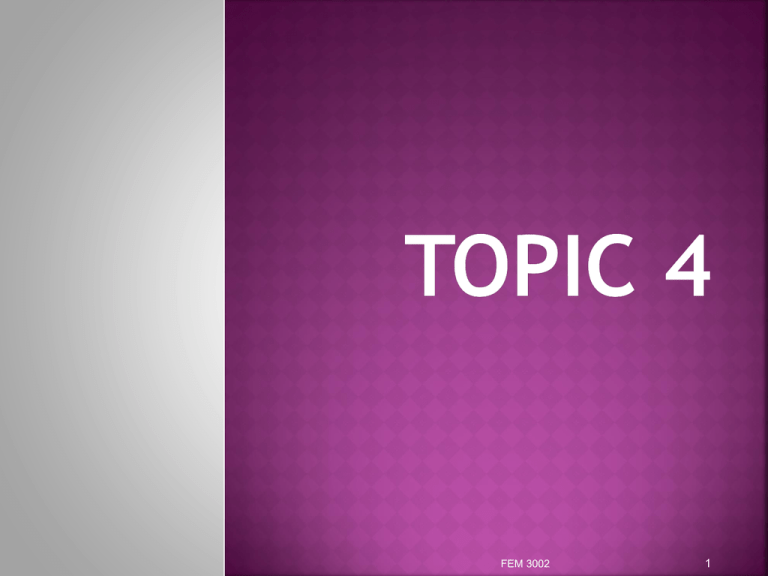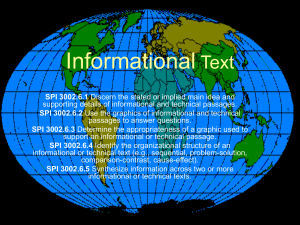I. What is a Research Proposal?
advertisement

FEM 3002 1 I. What is a Research Proposal? II. Format of a research proposal III. Description of a research proposal content Sample proposal FEM 3002 2 I. What is a Research Proposal? Research Proposal? Communicates a researchers plan for a study Research Report? Communicates what was actually done and what resulted FEM 3002 3 Writing a research proposal is an important component of a research activity. Writing for an academic requirement or to apply funding from a certain sponsor. For the academic purpose -- needs to be presented to a committee for approval. FEM 3002 4 1. 2. 3. 4. 5. 6. 7. 8. Title Introduction Literature Review Methodology Work Schedule Bibliography Budget Appendixes – Letters and Questionnaire FEM 3002 5 FEM 3002 6 The title refers to the issue focus on in the study. The selection of the title is based on what you are interested to study. A ‘good’ title has the following characteristics: contains less than 15 words contains variable (s) of the study describe the subject (e.g., adolescent, male adolescent, female adolescent, secondary school students, primary school students, preschool children, working women, dualearner couples) identify location (e.g., urban, rural, name of district, name of state) contains statistic words (e.g., relationship, comparison, predictor) The title is more of a label for the research and not written in a complete sentence, thus you will not put a period for a title. FEM 3002 7 Example 1: Mobile Phone Use amongst On-Campus Students in Universiti Putra Malaysia: Its Correlates and Impact on Psychological Health and Academic Achievement Example 2: Relationship between Parenting Behavior and Psychosocial Functiong of School-going Adolescents in Bandar Baru Bangi Example 3: Parenting Behavior of Mothers and Fathers of Children with Mental Disoders in Selayang Hospital FEM 3002 8 gives the You need general picture of what you want to study. to give general description of the purpose of the study, its relationship to the current phenomena, problems related to it and why it needs to be investigatied. In general this section gives answer to basic questions including ‘what’ and ‘why’ a study needs to be conducted. Subtopics in this section include: Statement of the problem Significance of the study Objective – general & specific Hypothesis Conceptual framework Definition of terminology (conceptual & operational) Limitation of study FEM 3002 9 In this section you need to declare in clear terms the specific problem you want to focus. In other words, tell exactly what you want to study. It must be stated in a ‘logico-empirical’ way, i.e., the problem must be concrete/tangible and can be measured. You want to address the questions that you are interested in, and which are appealing to your reader so that they too would agree with you that the study needs to be conducted. Describe briefly the background of the problem that you intent to study and how it can help you to answer ‘what’ you plan to study. FEM 3002 10 State what the study is in very clear term. Help communicate your ideas to others. Help guide the research process (e.g., what variables will be examined, what methods will be used). FEM 3002 11 State in simplest form. Stated as a question is preferable. Identify the variables being investigated. Indicate the relationships between the variables being investigated. Identify the target population. FEM 3002 12 The study was designed to identify factors that predict the parenting behaviors of mothers, and to explore whether or not the same factors predict the quality of care provided by Malays, Chinese and Indian mothers. The factors related to the achievement of children ages 6-8 years old, were also examined. factors related to parenting behaviors of mothers from different ethnic groups and their children’s achievement. Predictors of mothers’ parenting behaviors and achievement of children from different ethnic groups. FEM 3002 13 The purpose of this study is to determine what effect preschool experiences have on the socialization of children entering the first grade. The purpose of this study is to determine whether there is a difference in the rate of child abuse between female single families and male single-parent families. FEM 3002 14 This section explains to your reader or assessor the potential benefits of the research that you are going to conduct. You may describe how the results can be useful to a specific population or organization. FEM 3002 15 The objective of a study can be classify into two, i.e., 1). General objective and 2). Specific objective. This section discusses the two types of objectives. FEM 3002 16 Akin to its name this objective broadly describes the aim of the study. Words that can be used for this objective must be measurable, such as: Describe Explain Evaluate Examine Identify Determine Study FEM 3002 17 Example: This study aims to determine the relationships between the level of problematic mobile phone use and psychological health of college students. FEM 3002 18 This objective is more explicit, precise and related to the general objective. The purpose of this objective is to reflect on the method that will be used to achieve the objective of the study. When reporting your research results in your final report, you would definitely need to refer or relate them back to your objectives. Research objectives have direct relationships with the results that you will obtain. FEM 3002 19 Like the general objective, words that can be used in writing your specific objectives must be measurable, such as: identify determine examine evaluate compare FEM 3002 20 You must avoid using unmeasurable words in writing your specific objectives, such as: to ‘see’ to ‘understand’ to ‘know’ FEM 3002 21 Hypothesis refers to an educated guess that is developed to guide you on what the expected outcome of your research. It is a prediction that can be tested. However, students must understand that not all research need hypothesis (e.g., for exploratory and descriptive research). You would only need to write hypothesis when you plan to use inferential statistics. Your hypothesis should be derived /supported by the literature. FEM 3002 22 There are two types of hypothesis: 1). Null hypothesis, and 2). Alternative hypothesis. • Let’s refer to Lecture 4 for our discussions on hypotheses. • The following slides will present to you more samples of the different types of hypotheses. FEM 3002 23 The format for writing hypothesis is as follows: Null hypothesis HoX: There is no significant relationship between an independent variable and a dependent variable FEM 3002 24 Alternative Hypothesis HaX: There is a significant relationship between the independent variable and the dependent variable. FEM 3002 25 Ho1: There is no significant relationship between level of problematic mobile phone use and the academic performance of the secondary school students. FEM 3002 26 HaX1: The level of problematic mobile phone use is related to the academic performance of the secondary school students. HaX2: Students who are problematic mobile phone users are more likely to be less academically well. FEM 3002 27 A conceptual framework refers to the working model for your study. The model outlines your study variables, their positions and directions of effects. A good model is a useful model, that is, one that provides you with a clear direction of your research. FEM 3002 28 Important terminologies included in your study must be defined conceptually and operationally. FEM 3002 29 Operational definition For this definition you will give an exact specification of how a concept is measured or manipulated in your study. FEM 3002 30 Conceptual definition This is a general description of all the constructs, terms or variables that you have included in your study. In this definition you will provide an abstract characterization of all your constructs/terms/variables. FEM 3002 31 Example : Research Title: ‘Relationship between level of self-esteem and adolescent’s academic achievement’ Self-esteem Conceptual: A person’s overall selfevaluation or sense of self worth. Operational: Respondent’s score on the Rosenberg’s (1979) self-esteem scale. FEM 3002 32 In this section you need to discuss the restriction or drawback of your study with respect to aspects such as: Respondent Sampel size Location of study Sampling technique used Variables selected FEM 3002 33 Example 1: The current study focused on personal and family factors associated with mobile phone use and its impacts on psychological health and academic achievement of college students. Other factors and impacts of the mobile phone may also be pertinent to explore, but was not the scope of the present study. Sample for the study would include only on-campus students of UPM, identified via cluster sampling. Those residing off-campus will not be selected for the study. FEM 3002 34 The "literature" of a literature review refers to any collection of materials on a topic. It could be anything from a set of government pamphlets to scholarly published articles (i.e., non-fiction). When you conduct a literature review you discuss published information in a particular subject area, and sometimes information in a particular subject area within a certain time period. The review can be just a simple summary of the sources, but it usually has an organizational pattern and combines both summary and synthesis. FEM 3002 35 Literature reviews typically contain three basic elements: 1) An introduction or background information section Provides a quick opening of your topic, including its central theme and organizational pattern. 2) The body of the review Contains your discussion of sources and is organized chronologically, thematically, or methodologically. 3) A conclusion and/or recommendations section to end the paper. Discuss what you have drawn from reviewing literature, and where might proceed. FEM 3002 36 1. Examining the available body of knowledge in your area of interest. 2. Sets the stage for successful completion of research proposal and study. 3. A continuous process from beginning of research to ending. FEM 3002 37 4. Beginning: to become familiar with the research topic. 5. Ending: to integrate/compare your research findings with that of others. FEM 3002 38 1. 2. 3. 4. Search for existing literature in your area of study. Review the literature selected. Develop a theoretical framework; and Develop a conceptual framework. FEM 3002 39 General sources: Provide an overview of a topic and leads to find more information. e.g., newspapers, popular periodicals & magazines, trade books, Readers Guide to Periodical Literature FEM 3002 40 Secondary sources: Provide a level of information not from the original source. e.g., books give information on specific subjects Summary of selected research. FEM 3002 41 Primary sources: An original report of the original work or experience. e.g., journals, abstracts, and scholarly books, ERIC, movies FEM 3002 42 The methodology presents the reader with your research design. There are at least four sections you will discuss here: 1). Study location Indicate where you want to conduct your study FEM 3002 43 2). Population and Sampel selection Indicate which group of people you want to study Discuss whom you would include in your sampling frame, which would you select as your respondents, and what would be your sampling technique? FEM 3002 44 3) Data collection Discuss your measurements for both independent and dependent variables Discuss the tool you would use for your data collection – e.g., questionnaire, observation scale? Discuss what method you would use to collect your data – e.g., survey, case study? What technique would you use – e.g., face-to-face interview, mail interview, telephone interview? FEM 3002 45 4). Data analysis Discuss what statistics you would use to describe data and test your hypothesis. Discuss the results that you expected, you may want to present these using dummy tables. FEM 3002 46 Work schedule is important for you to plan and present the processes that possibly may take place in your research. The expected time frame you need to complete your research depends very much on the scope of your research. FEM 3002 47 At the end of your proposal/thesis report your will need to list down all the references that you have cited in the text. The bibliography maybe written using the format/style provided by the American Psychological Association (APA). FEM 3002 48 In your proposal, you will include a section where you would indicate the estimated amount of money you need to conduct your research. This section is very important especially when you are planning to apply for funds/grants from any institution or organization. FEM 3002 49 At the end of your proposal, you would attach an appendix or appendixes containing materials related to your research project such as: Letters Questionnaire Instruments Newspaper clipping FEM 3002 50








